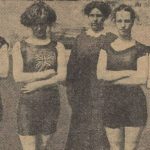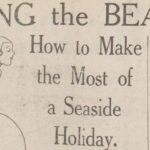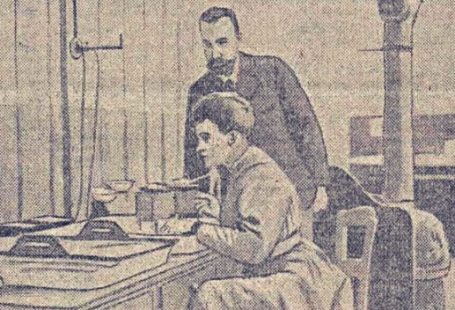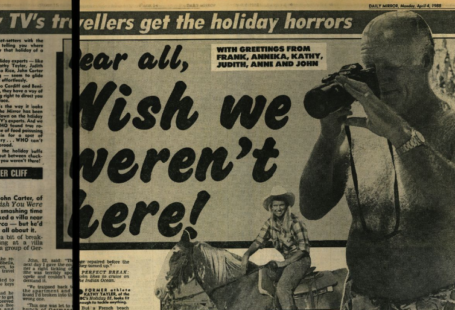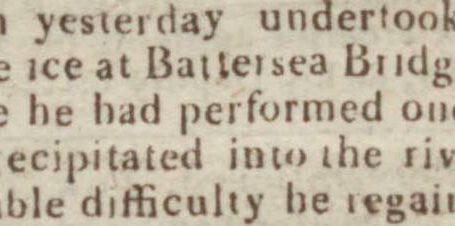This week at The Archive has been a truly remarkable one, as we have achieved the landmark of 44 million pages all now available to view on the site. Furthermore, we have added another 201,178 brand new pages over the past seven days, with the addition of an incredible fifteen new titles, including specialist sporting and fashion titles.
So read on to discover all about our new titles of the week, which include famed fashion industry publication the Tailor & Cutter, as well as to discover more about history’s best and worst dressed!
Register now and explore the Archive
First up this week is a very special new arrival, namely the Tailor & Cutter. Initially founded in Scotland in 1866 by John Williamson, the publication’s first incarnation demanded improved working conditions for tailors, cutters and other workers within the fashion industry.
However, John Williamson moved in the same year to London, taking with him his idea for a newspaper dedicated to the tailoring trade. There, with the help of wealthy benefactor Angelica Patience Fraser he founded not one but two publications – the Tailor and the Cutter – which eventually merged to form the Tailor & Cutter.
Tailor & Cutter | 15 March 1900
Williamson’s aim was to provide communication and technical information to the tailoring community, and in 1869 he stated:
Our mission is to put a superior class of literature dealing with the science and art of the trade into the hands of every tailor.
John Williamson, again with the help of Angelica Fraser, went one further, establishing the Tailor’s School of Art on Drury Lane, which was to become a ‘world renowned tailoring academy.’ In 1902 the institution moved to Gerard Street; Williamson’s publication all the while dovetailing with the Tailor’s School of Art.
In 1907 the Tailor & Cutter advertised itself as ‘tailoring’s own journal,’ containing ‘the Latest Fashions, the Best Cutting Systems, Information on Practical Tailoring’ as well as ‘Essays on Business Management.’ Indeed, the publication served as a guide to tailoring as a whole – from the art of the trade, to its business and operational aspects.
Tailor & Cutter | 10 March 1910
Typical editions of the Tailor & Cutter, which appeared weekly at the cost of two pence, would feature such articles as ‘Principles of Scientific Cuttings,’ and illustrations of the latest ‘British costumes.’ Meanwhile, it contained patterns and instructions for constructing such garments as ‘Cycling Knickers and Breeches.’ You could also find within its pages news from the tailoring trade from across Britain, from Manchester, Leeds and London’s West End, for example, as well as advice on ‘Emigration Prospects for Tailors.’
Although dedicated to men’s fashion, and capitalising from the notion that British men were the best dressed in the world, an idea that the Tailor & Cutter conscientiously promoted, the publication did feature womenswear, before a separate title was established for women’s tailoring in 1884.
Tailor & Cutter | 28 June 1900
Surviving into the 1930s and flourishing at the same time, in 1930 the Tailor & Cutter boasted that it had ‘the largest circulation of any trade journal in the world issued for the tailoring, clothing and allied trades.’ And then in 1932 it labelled itself the ‘leading authority on clothes.’ But by 1945 the Tailor & Cutter had demurred; and was now describing itself simply as an ‘authority on clothes.’
With the rise of ready-to-wear clothing throughout the 1950s and 1960s, and the decline in the tailoring trade, the end was on the horizon for this magnificent and historic title. The latest edition of the Tailor & Cutter appeared in 1972.
We are delighted to welcome another specialist title to The Archive this week, which joins our collection of sporting titles. ‘Great National Sunday Newspaper’ the Empire News & The Umpire was first published in Manchester on 4 May 1884 as The Umpire, and was subtitled ‘A Sporting, Athletic and General Newspaper.’
Initially circulating in Manchester and district, alongside the ‘all the latest sporting and theatrical news,’ The Umpire featured ‘general news and telegrams,’ and was owned by H.S. Jennings. Politically independent, special segments of the newspaper included ‘Sweets and Bitters,’ a round-up of news, and ‘Stage Whispers,’ which contained the latest from the theatres.
Empire News & The Umpire | 8 June 1884
Consisting of eight pages, the The Umpire also published such features as ‘Ancient Cricketers,’ which profiled cricketers from the past, and of course all the latest sporting results, focussing on cricket, football and racing. Sport was at the heart of this publication, with a further feature ‘Sporting Fancies’ included within its pages, sitting alongside general news and other ‘Mixed Clippings.’
The Umpire soon became a runaway success, absorbing in 1894 the Manchester Examiner and Times. In 1917 the title was bought by Edward Hulton, the British newspaper proprietor. Hulton’s father had founded such sporting titles as the Sporting Chronicle and Athletic News, as well as the Sunday Chronicle and the Daily Sketch. Hulton changed the name of his new newspaper to Empire and then to the Empire News. It was then acquired by Canadian newspaper magnate Lord Beaverbrook, who then sold it to fellow newspaper magnate Lord Rothermere.
Empire News & The Umpire | 7 April 1901
In 1944 the Empire News was renamed the Sunday Empire News, before becoming in 1950 the Empire News & The Umpire. The title was then merged with the Sunday Chronicle in 1955, and in 1959 it was bought by Roy Thomson. In 1960, production of the Empire News & The Umpire finally came to an end, as it was absorbed by the News of the World.
We now move on to the thirteen new titles of the week that have been digitised as part of the British Library’s Heritage Made Digital Programme, a programme which is devoted to preserving newspapers which are in a poor condition, and bringing lesser known titles to light.
And talking of light, one of these new titles is the wonderfully named Aurora Borealis, or northern lights. First published on 25 March 1821 with the motto ‘Nemo Me Impune Lacessit’ – ‘No One Provokes Me with Impunity’ – Aurora Borealis promised to shine a northern light in London.
Aurora Borealis | 31 March 1821
Indeed, it addressed ‘Private gentleman, writers and others having LANDED PROPERTY to sell, MANSIONS, SPORTING BOXES &c. to let,’ respectfully informing them that the first number of new newspaper Aurora Borealis was set to be published the following Sunday. And what was remarkable about Aurora Borealis, aside from its unusual name? It was set to be a ‘Scotch newspaper in London,’ or more precisely, to be the ‘only Scotch Paper published in London.’
So alongside the news from parliament and from abroad, the Aurora Borealis had a focus on Scottish news, including the latest from the Scottish markets, as well as featuring correspondence and notices of births, marriages and deaths.
Another unusually named newspaper joining us this week is the London Phalanx. The London Phalanx was first published on 3 April 1841, and was dedicated to expounding the theories of French philosopher Charles Fourier (1772-1837), who had died just a few years earlier.
Fourier was an early exponent of socialist thinking, and is considered to be one of the founders of utopian socialism. Ahead of his time, he is even credited with originating the word ‘feminism.’ His main theory centred on how concern and co-operation were the secrets of social success, with workers being recompensed for their labours based on the efforts which they had put in.
London Phalanx | 25 September 1841
Vehemently opposed to trade, which he saw as the root of all evil, Fourier’s social utopia was founded on the idea of communities called ‘phalanxes.’ He believed there were 12 common passions, fuelling 810 types of character, and therefore the ideal phalanx would contain 1620 people in total.
And so the London Phalanx came onto the British publishing scene with ‘a special mission,’ namely to:
…draw the attention of the British Public to those Principles of general Policy and Social Progress which have been brought to light by the genius of the late Charles Fourier.
It moreover detailed how the name ‘phalanx’ indicated a ‘united Body of Co-operators in the field of progress,’ and how its leading features would be ‘News, Reviews, Associations, Colonization, Religion and the General Principles of Progress in Society.’
The London Phalanx also detailed parliamentary proceedings, featuring news from Ireland, France, Spain and the United States, as well as reporting on drama, books and periodicals, and the markets.
Another of our new newspapers this week with a social mission at its heart is the London Journal and Pioneer Newspaper. Established as the organ of the Manchester Unity of Odd Fellows, a fraternal order which was founded in Manchester in 1810 to help its members and communities in times of need, the London Journal and Pioneer Newspaper was first published on 15 March 1841. Prominent members of the society have included George IV, Winston Churchill and Stanley Baldwin.
Costing six pence and appearing every Saturday, the London Journal represented to some ‘the enlightened movement and a singular illustration of the spirit of the times,’ as it was based upon a charitable movement.
London Journal and Pioneer Newspaper | 17 May 1845
Within its pages you could find a ‘History of the Week,’ alongside ‘Intelligence’ communications centring on the railways, law, the assizes, the police and parliament. There were also sections devoted to general news and the markets, as well as columns dedicated to the Order of Odd Fellows.
We have also published more radical newspaper titles this week from the early nineteenth century, at a time when political reform was demanded from many sections of society. One such of these newspapers was Public Cause, which was first published in October 1811 with this rallying subheading illuminating its mission: ‘The Cause for which Hampden bled in the Field, and Sidney died on the Scaffold.’
The Hampden to which the Public Cause refers is John Hampden, who fought on the side of the Parliament in the English Civil War, who was a cousin of Oliver Cromwell and was on one of the Five Members whose arrest helped to spark the conflict. Hampden died from his wounds in 1643 following the Battle of Chalgrove Field, and by the early 1800s he was enshrined as a kind of radical martyr, referenced to by poet Percy Shelley.
Indeed, Hampden Clubs began to appear across Britain at this time, set up by the radical movement as debating societies and spaces for political campaigning. They were, of course, named after John Hampden. The original Hampden Club was founded by English naval officer John Cartright, a prominent campaigner for political reform.
Public Cause | 13 November 1811
Public Cause was also allied to the memory of Algernon Sidney, an English Whig who was executed for allegedly plotting to overthrow the government of Charles II. Like John Hampden, Sidney was too revered as a ‘Whig patriot – hero and martyr.’
Public Cause was, therefore, tied to the reform movement. Within its pages you can find such sections as an ‘Abridgement of Politics,’ ‘Foreign Intelligence’ and ‘Letters to the Editor.’ Indeed, Public Cause wrote and published its own letters, to none other than the Prince Regent, protesting the political conditions of the day. Meanwhile, the newspaper also featured poetry, notices of accidents, offences and bankruptcies, and the latest police news.
Another new radical title to join us this week is Wooler’s British Gazette. First published on 3 January 1819, Wooler’s British Gazette got its name from Thomas Jonathan Wooler (1786-1853), a Yorkshire born radical. Wooler had moved to London to pursue a career in printing, working first as a printer’s apprentice before working at radical title The Reasoner and going on to edit The Statesman.
After the so-called ‘Gagging Acts’ (the Treason Act and the Seditious Meetings Act) were passed in 1817, Wooler went on to establish his own radical and unstamped journal named the Black Dwarf. Wooler was arrested three months into his new venture for libel, allegedly against Lord Liverpool’s government. Acting as his own defence, Wooler convinced a jury that he had not himself written the article in question, and he was acquitted.
Wooler’s British Gazette | 2 May 1819
Wooler used the Black Dwarf as a vehicle for reform, and he edited Wooler’s British Gazette with the same reforming motivation. His British Gazette cost 8 ½ pence and consisted of eight pages, with such sections as ‘Foreign Intelligence,’ ‘Provincials,’ and ‘Military Affairs.’ It also contained poetry, the latest from the theatre and from the police, as well as reviews of ‘new publications.’
Wooler quit the publishing game in 1832 when the Reform Act was passed, becoming a lawyer. He went on to publish several books, including Every Man Is His Own Lawyer in 1845, no doubt harking back to his successful defence of himself when he was a younger man.
And although Wooler might have quit the publishing game, there were other reforming publishers, printers and editors ready to follow in his footsteps. Enter, then, the True Sun. A radical pro-Whig evening newspaper, the True Sun was first published on 5 March 1832 and cost seven pence. Proclaiming itself to be the ‘Largest of the Evening Newspapers,’ the True Sun was the workplace of a young Charles Dickens from 1832 through to 1834.
The True Sun claimed to bestow more care ‘on condensing and arranging news, than in any other Daily Paper,’ whilst also containing ‘a greater mass of News…than any other Evening Paper.’ But at the heart of the True Sun was its politics, for the ‘politics of the True Sun will be the politics of reform.’
Owned by Patrick Grant, published by John Bell and printed by John Ager, the True Sun was an organ of radicalism. Indeed, the trio of Grant, Bell and Ager were all imprisoned in 1834 for advocating resistance to the Window Tax.
In 1835 the True Sun was purchased by D. Whittle Harvey, and in 1837 it was bought by Murdo Young, who then merged the titled into the Sun, which ran between 1792 and 1871.
Some ten years later and another reforming publication had burst onto the scene, stridently named the Standard of Freedom. First published on 1 July 1848, the Standard of Freedom appeared every Saturday at the cost of five pence and stood for ‘Political, Commercial and Religious Freedom.’ Established by printer, publisher and editor John Cassell (1817-1865), the newspaper promised to be an ‘Advocate of Political, Commercial, and Religious Liberty, Equitable Taxation and Retrenchment.’
These were all causes close to Cassell’s heart. John Cassell, also a tea and coffee merchant, was a famed social reformer, who was passionate about improving the lives of the working classes, especially in terms of bringing education and culture to the masses. An advocate of the temperance movement, Cassell is now perhaps best remembered for the company he founded, Cassell & Co., which produced educational books and periodicals.
Standard of Freedom | 9 February 1850
His newspaper, the Standard of Freedom, was therefore aimed at the popular market, with its emphasis on free trade and religious liberty. Within its pages you could find the usual news from abroad and the provinces, alongside the latest from temperance societies, ecclesiastical and religious news, as well as reports from the ‘Financial Reform Movement.’ The Standard of Freedom also had a focus on emigration; providing an ‘Emigrant’s Miscellanea’ for those looking to emigrate to Australia, South Africa or the United States, and a column entitled the ‘Emigrant’s Informant.’
The Standard of Freedom was published for three years, before it was merged in 1851 with the Weekly News and Chronicle.
Alongside the Standard of Freedom we have also published this week Constitution (London). A Sunday newspaper, Constitution (London) cost seven pence and consisted of four pages. Both liberal and independent, it represented a summary of all the week’s news:
The CONSTITUTION is one of the largest Papers published, and conducted upon liberal and independent principles. It is extremely well calculated for those who do not pursue the Daily Papers, as it furnishes all the most interesting Foreign and Domestic News of the Week, with the Police Intelligence, &c.
Constitution (London) | 23 August 1818
If this wasn’t enough, the Constitution claimed to contain ‘one-fourth more in quantity than most other Papers, although it is sold at a lower price.’ Featured within its pages were extracts from the German, Dutch and American papers, as well as agricultural reports, the latest from coroners’ inquests and the theatres, notices of bankruptcies and commentary on the month’s fashions.
Another newspaper with bold claims was the Observer of the Times. First appearing on 7 January 1821, the Observer of the Times claimed to be ‘the largest Sunday Paper published.’ Printed on ‘fine wove paper’ in a ‘very beautiful new type,’ the Observer of the Times began to include engravings from July 1821.
Indeed, the Observer of the Times featured engravings of George IV’s coronation, which it described as being ‘illustrative of this splendid Ceremonial,’ featuring depictions of the interiors of Westminster Hall, where the coronation feast was held, and Westminster Abbey.
Observer of the Times | 23 July 1821
The Observer of the Times cost seven pence, and featured the latest from the Court of Sessions and the police, as well as sporting news, with a focus on boxing, agricultural news, and notices of births, marriages and deaths.
Also joining us this week is the London Moderator and National Adviser. Printed and published by T.J. Fenwick between 1813 and 1823, the London Moderator and National Adviser appeared every Wednesday and cost eight pence. Filled with news of the day, the London Moderator contained a ‘Political Retrospect’ as well as reports from both the House of Commons and the House of Lords.
London Moderator and National Adviser | 5 May 1813
Alongside reports from the assizes and ‘Religious Institutions,’ the London Moderator featured some in-depth articles, such as its incredibly detailed examination ‘of the Conduct of the Princess of Wales’ in 1813. Also contained within its pages were notices of recent accidents, offences and bankruptcies.
Alongside the Moderator this week we have also added the Instructor – namely, the Instructor and Select Weekly Advertiser. Published every Wednesday at the cost of eight pence, the Instructor and Select Weekly Advertiser was ‘designed to afford a reasonable Knowledge of the passing Events in the World, and at the same time to assist the Cause of Religion in the Promulgation of Evangelical Truths.’
First appearing on 9 September 1807, initially at the lower price of six pence, the Instructor and Select Weekly Advertiser was published in quarto format, ‘on the largest Size Paper that can be made, to contain twenty-four columns of letter press.’
Instructor and Select Weekly Advertiser | 5 October 1810
But what could you expect from the pages of this newspaper, which was published from Covent Garden? An advert for this new title tells how:
This publication will contain every description of useful Information that can be found in any of the Newspapers extant; together with the latest Religious, Political, and Miscellaneous Intelligence – Prices of Stock, and correct Market Tables, up to Four o’Clock on the day of Publication.
Given its stated mission to assist the ‘Cause of Religion,’ the Instructor and Select Weekly Advertiser featured a range of religious focused sections, including news from the ‘Religious World’ and a ‘Christian Miscellany.’ You can also find within its pages a list of upcoming lectures (with a religious theme), as well as international news and a ‘Weekly Retrospect.’
Our penultimate new title of the week is the London Evening Post. Appearing three times weekly on Tuesdays, Thursdays and Saturdays the London Evening Post cost six pence and ran with the motto ‘Domine Dirige Nos’ – ‘Lord Guide Us.’
Containing ‘Very Valuable Information,’ the London Evening Post featured:
…a Postscript of Original Information, viz. the chief contents of the Hamburg Mail – the Paris Papers – Novelties in Literature – New Discovers in the Arts, and in Agriculture, now a subject of universal attraction – a regular and accurate statement of the Markets… together with a faithful Report of the Proceedings in Parliament, and of all Law Cases in the different Courts.
London Evening Post | 17 October 1805
Moreover, the London Evening Post promised to attend ‘with the strictest impartiality’ to all of these items, so that it would be:
…essentially useful to every Merchant, Lawyer, and Farmer, in these Kingdoms; and to which Gentlemen of that description all over the Continent, in America, and the East and West Indies, may refer as a proper Repository for the most valuable information.
Our final new title of the week is the historic General Evening Post. Historic evening newspaper the General Evening Post first appeared in September 1733, printed and published by J. Roberts. An advert from 1733 describes how the General Evening Post will contain:
…the Exact Price of Stocks on those Days [it was published], the best and freshest Account of all Foreign and Domestick News, with whatever else can render a News-Paper useful to the Publick; in particular, a List of Estates to be sold in all Parts of the Kingdom, will be inserted on proper Occasions.
General Evening Post | 24 January 1801
Published every Tuesday, Thursday and Saturday, and consisting of four pages, in the early 1800s the General Evening Post cost six pence, and featured international and national news, news from London, as well as a ‘Weekly Retrospect.’
We have also updated seven of our existing titles this week, with updates to two of our sporting publications. We have added the year 1913 to Boxing, as well as a range of new years to the Sporting Chronicle. Full details of all of our new and updated titles can be found at the end of this blog.
History’s Best and Worst Dressed
Our new fashion trade publication the Tailor & Cutter, as well as providing practical advice on the tailoring and cutting trade, also offered its own commentary on the most fashionable personalities of the day. Here, we take a look at some of these commentaries, and the unique perspective offered by this wonderful title.
In September 1890 the Tailor & Cutter asked ‘Who is the Best Dressed Man?’ In the ‘point of dress’ Anglo-Irish peer, journalist and Tory politician Lord Dunraven ‘ was certainly the pick of the basket of noble lords,’ although the newspaper humorously remarks that any man whose tailor uses the patterns provided by the Tailor & Cutter was likely to be the best dressed of his acquaintance.
Lord Dunraven | The Sketch | 13 August 1913
Three years later in March 1893 the Tailor & Cutter gives a fascinating survey of ‘Dress in Parliament,’ with the ‘best dressed men’ being the young Tory politicians. However, there was an immense range of dress exhibited in the House of Commons, as the article relates:
There is Mr. George Howell, for example, in a pot-hat and a capacious go-to-meeting-house-black-broadcloth. There is Mr. William Randall Cremer in a snuff-coloured Tweed and low felt hat. There is Mr. Fenwick in the garb of ‘office,’ and Mr. Keir Hardie in a workman’s cloth cap and woollen shirt.
These were a new breed of politicians; Keir Hardie of course being the founder of the Labour Party, and George Howell being a trade unionist Liberal-Labour MP. And amongst these more sedate dressers were the peacocks of parliament; Sir John Swinburne favouring ‘a green tie, yellow trousers, and a grey coat,’ and one Mr. Channing with his statement eyeglass, which finished ‘an irreproachable toilet.’ Future Prime Minister Lloyd George was also praised by the Tailor & Cutter for his choice of clothing.
Penny Illustrated Paper | 10 July 1886
And within the government also were some relics of dandyism, including veteran statesman the Duke of Rutland:
The dandy of the late Government is the Duke of Rutland, who in a black Frock Coat, light grey Trousers, perennial white Vest, white gaiters over varnished boots, and a ‘dossy’ silk hat, with the finish of an eye-glass, still typifies the ‘young England’ of his youth.
Meanwhile, there were other contenders for the best dressed men of the day – with peer Lord Chesterfield and the Hon. Henry Stoner counted as ‘men of fine figure, and a pleasure to any tailor to dress’ in an article from April 1893. The same article also lauds the Duke of Connaught, son of Queen Victoria,’ as ‘one of the best turned out men in England.’ The future King George V is said also to ‘dress very well indeed, though of course he’s short.’
The Duke of Connaught | Illustrated London News | 15 March 1879
Fast forward to September 1898 the Tailor & Cutter was having a talk with an ‘expert clothes-cutter,’ Mr. Chisholm, who was asked ‘Who is the best dressed man in London?’ The fashion expert replied:
‘A difficult question. Probably the Hon. C.R. Spencer may hold that position. Mr. Kemp, M.P. for the Heywood division of Lancashire, is probably the dressiest man in the House of Commons.’
Illustrated London News | 29 May 1880
Whilst in 1909, on the subject of ‘The Best Dressed M.P.,’ one Mr. Chellew told a ‘men’s gathering at Harlsedon’ that he considered ‘Mr. Lloyd George…a well-dressed man,’ but the honour of the best-dressed man in the House of Commons ‘unhesitatingly’ went to Mr. Wyndham.
But who was the ‘worst dressed man in Westminster,’ at least according to the Tailor & Cutter? That particular dishonour fell to Tory politician Lord Robert Cecil, about whom the Tailor & Cutter remarked in 1916:
The last time we saw Lord Robert was at a country flower-show in his constituency and we chanced, at the time, to be in the company of a London cutter of some celebrity. The brilliant Under-Secretary for Foreign Affairs wore a soft black felt Trilby hat, and a dark grey rainproof Chesterfield overcoat, and the most casual observer could see he took but little pride in his dress.
Lord Robert Cecil | Illustrated London News | 3 March 1923
The article somewhat scathingly continues:
In physique he is not exactly an Adonis, as he has a pronounced stoop, said to be common with clerics and literati. On the occasion referred to, the cutter in question, after critically observing the noble lord’s physical proportions, remarked that he did not envy the tailor who had to fit so difficult a figure.
Poor Lord Robert! Nevertheless we hope you enjoyed this foray through history’s best and worst dressed – what other discoveries will you be able to find within the pages of the Tailor & Cutter?
New Titles
Title |
Years Added |
| Aurora Borealis | 1821 |
| Constitution (London) | 1818-1819 |
| Empire News & The Umpire | 1884-1895, 1897-1911 |
| General Evening Post | 1801-1813, 1818-1822 |
| Instructor and Select Weekly Advertiser | 1810-1811, 1813-1814 |
| London Evening Post | 1805-1806 |
| London Journal and Pioneer Newspaper | 1845-1846 |
| London Moderator and National Adviser | 1813, 1818-1819 |
| London Phalanx | 1841-1843 |
| Observer of the Times | 1821-1822 |
| Public Cause | 1811-1812, 1814-1816 |
| Standard of Freedom | 1850-1851 |
| Tailor & Cutter | 1866-1868, 1879-1918 |
| True Sun | 1832-1837 |
| Wooler’s British Gazette | 1819 |
Updated Titles
This week we have updated seven of our existing titles.
You can learn more about each of the titles we add to every week by clicking on their names. On each paper’s title page, you can read a FREE sample issue, learn more about our current holdings, and our plans for digitisation.
Title |
Years Added |
| Boxing | 1913 |
| Englishman | 1803-1809, 1812-1813, 1816-1834 |
| Morning Herald (London) | 1853, 1863 |
| Oxford Chronicle and Reading Gazette | 1918, 1920 |
| Press (London) | 1860 |
| Sporting Chronicle | 1874, 1891, 1897, 1902, 1904-1905, 1921 |
| Swindon Advertiser | 1913 |
You can keep up to date with all the latest additions by visiting the recently added page. You can even look ahead to see what we’re going to add tomorrow.

























